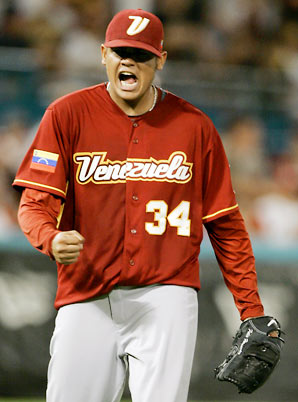The third installation of the WBC is upon us. As many have noted the teams, especially the U.S. team, seem to be lacking in star power. Many baseball insiders believe that the WBC causes an abnormal amount of stress on players, especially pitchers, and that it hinders their regular season performances. Coaches, players, and owners alike are all figuring out ways to keep stars from playing in the tournament. The thing is, no one really knows if the fears are valid, or if pitching a few innings in a “meaningful” tournament, as opposed to a fun, stress free environment (for stars who have major league contracts) like spring training makes any difference.
The following exercise takes a sample of 2009 WBC pitchers, and compares their performances to non-WBC year baselines. Hopefully, we’ll see if the see if there is any proof in this pudding.
I am going to steal a technique from one of my favorite baseball writers, Dave Cameron of U.S.S. Mariner, and put up some blind stat lines to compare different players without bias.
Player A: 8-6, 181.1 IP, 4.12 ERA, 1.241 WHIP, 138 SO, 100 ERA+, 2.1BB/9, 6.8K/9
Player B: 13-13, 211.2 IP, 2.76 ERA, 1.025 WHIP, 193 SO, 145 ERA+, 2.3BB/9, 8.2K/9
We can see from these stat lines that player B performed significantly better than player A over the course of the season. Player B pitched more innings, struck out more batters, had a better ERA and park adjusted ERA, and although he walked a few more batters per 9, his WHIP was significantly better.
Player C: 19-5, 238.2 IP, 2.49 ERA, 1.135 WHIP, 217 SO, 171 ERA+, 2.7 BB/9, 8.2 SO/9
Player D: 13-12, 249.2 IP, 2.27 ERA, 1.057 WHIP, 232 SO, 174 ERA+, 2.5 BB/9, 8.4 SO/9
In this comparison we see that although Player D fared slightly better in every stat category, he had a significantly worse W-L record. We can also note that although one season is better than the other, both are incredible seasons and nothing to scoff at.
Player E: 4-6, 59.1 IP, 5.76 ERA, 1.871 WHIP, 54 SO, 81 ERA+, 4.6 BB/9, 1.80 SO/9
Player F: 9-6, 153.2 IP, 4.69 ERA, 1.373 WHIP, 133 SO, 93 ERA+, 4.3 BB/9, 1.80 SO/9
This comparison gets interesting, Player F clearly had a better season than Player E, but Player E obviously missed a significant period of time. In the end, neither pitcher did very well (were terrible).
Player G: 15-10, 219.1 IP, 2.87 ERA, 1.026 WHIP, 238 SO, 143 ERA+, 1.8 BB/9, 9.8 SO/9
Player H: 10-10, 157.1 IP, 5.32 ERA, 1.398 WHIP, 121 SO, 81 ERA+, 3.7 BB/9, 6.9 SO/9
This comparison marks the first set where the top line is better than the bottom; and what a difference it is indeed. Player G had a very good season, great numbers, and clearly was an asset to his team. Player H was a below average pitcher and performed poorly enough to really question his roster spot.
Now to reveal the pitchers and explain what this all has to do with the World Baseball Classic.
Player A is Roy Oswalt during the 2009 season after he competed in the 2009 WBC, He pitched for the US team, leading the squad in innings pitched with 11.1.
Player B is Also Roy Oswalt but in the 2010 season, having participated in a regular spring training.
The sets continue this way with players C and D being Felix Hernandez in 2009 and 2010. He pitched 8.2 innings for Venezuela during the WBC. Players E and F, Daisuke Matsuzaka (14.2 innings during the ’09 WBC) and G and H, Javier Vasquez (9.1 innings for Puerto Rico during the WBC).
Each of these players pitched the most innings or second most innings for their country during the WBC in 2009 (Hernandez came second to Carlos Silva and Dice K behind Hisashi Iwakuma). I chose not to use Silva because he was a horrible pitcher during the both the 2009 and 2010 seasons (and most other years) and because Iwakuma first came to the MLB this past year. Also, these players have significant statistical information available for their time in the Major Leagues.
What does all of this mean? We can see that of the four pitchers only Vasquez had a better season the year he pitched during the WBC than the year after. We can also see that Dice K got hurt the year he pitched in the WBC, that Oswalt had a better 2010 than 2009, and that Felix had CY Young caliber seasons in both years (because when does he not?) and that the differences between the seasons were very minute.
So we’ve got one injury, one pitcher that performed worse, one pitcher that performed better and one pitcher who finished 2nd in the Cy Young the year of the classic and won it the next. We basically have nothing. By basically nothing, I do in fact mean that in reality we have no significant statistical evidence either way. We do not know whether the WBC affects pitchers negatively or positively; what we do know is that even the pitcher who pitched the most innings in the 2009 WBC only pitched 20 innings (Iwakuma), and that any of these players would have pitched that many innings during spring training. We know that we have not just a small sample size but a tiny one, and that with that sample size one could make only rash judgments.
I am looking forward to this years WBC and am happy that the only bright spot for my team’s season, Felix, will be pitching for Venezuela again this year. I would not stop him and I would hope that no one does so in the future.
-David Ringold













